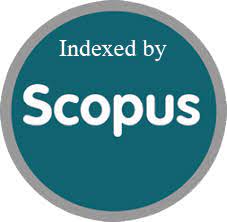Comparison of PaO2/FiO2 ratio with SpO2/FiO2 ratio in Respiratory Failure patients
DOI:
https://doi.org/10.52783/jns.v14.3335Keywords:
Respiratory failure, S/F ratio, P/F acute lung injury, ARDSRespiratory failure, S/F ratio, P/F acute lung injury, ARDSAbstract
Background: Respiratory failure is marked by inadequate oxygen delivery to tissue or insufficient carbon dioxide removal, commonly categorized into type 1 (hypoxemia) and type 2 (hypercapnia) respiratory failure. The diagnostic criteria for acute lung injury (ALI) and acute respiratory distress syndrome (ARDS) rely on the PaO2/FiO2 (P/F) ratio obtained through arterial blood gas (ABG) analysis to evaluate the severity of hypoxemia. We hypothesized that pulse oximetry saturation SpO2/FiO2 (S/F) ratio could serve as an alternative to the P/F ratio for assessing the oxygenation parameters associated with ALI.
Methods: This periodic observational study included 59 patients with acute respiratory failure. This study aimed to assess the sensitivity and specificity of the S/F ratio as a surrogate for the P/F ratio in diagnosing ALI and ARDS. FiO2, SpO2 and PaO2 levels were recorded at five-minute intervals, and the relationship between S/F and P/F ratios was analyzed using linear regression and receiver operating characteristics (ROC) curves.
Results: There is a significant positive correlation between S/F and P/F ratios, with a linear regression equation of S/F = 183.819 + 0.299 + P/F (r=0.607). For diagnosing cut-off of 272 yielded a sensitivity of 77.3% and specificity of 80%, while for ARDs an S/F cut-off of 247 showed a sensitivity of 69.6% and specificity of 83%. The ROC curve analysis indicated good discrimination abilities for both ARDS (AUC = 0.764) and ALI (AUC=0.786) using the S/F ratio.
Conclusion: S/F ratio provides an alternative for assessing oxygenation and diagnosing ALI and ARDS.
Downloads
Metrics
References
Lamba TS, Sharara RS, Singh AC, Balaan M. Pathophysiology and Classification of Respiratory Failure. Crit Care Nurs Q. 2016;39(2):85-93. doi:10.1097/CNQ.0000000000000102
Singh G, Gladdy G, Chandy TT, Sen N. Incidence and outcome of acute lung injury and acute respiratory distress syndrome in the surgical intensive care unit. Indian J Crit Care Med. 2014;18(10):659-665. doi:10.4103/0972-5229.142175
Matthay MA, Arabi Y, Arroliga AC, et al. A New Global Definition of Acute Respiratory Distress Syndrome. Am J Respir Crit Care Med. 2024;209(1):37-47. doi:10.1164/rccm.202303-0558WS
Mokrá D. Acute lung injury - from pathophysiology to treatment. Physiol Res. 2020;69(Suppl 3): S353-S366. doi:10.33549/physiolres.934602
Rice TW, Wheeler AP, Bernard GR, et al. Comparison of the SpO2/FIO2 ratio and the PaO2/FIO2 ratio in patients with acute lung injury or ARDS. Chest. 2007;132(2):410-417. doi:10.1378/chest.07-0617
Castro D, Patil SM, Zubair M, Keenaghan M. Arterial Blood Gas. In: StatPearls. Treasure Island (FL): StatPearls Publishing; January 8, 2024.
Merlani P, Garnerin P, Diby M, Ferring M, Ricou B. Quality improvement report: Linking guideline to regular feedback to increase appropriate requests for clinical tests: blood gas analysis in intensive care [published correction appears in BMJ 2001 Oct 27;323(7319):993]. BMJ. 2001;323(7313):620-624. doi:10.1136/bmj.323.7313.620
Bilan N, Dastranji A, Ghalehgolab Behbahani A. Comparison of the spo2/fio2 ratio and the pao2/fio2 ratio in patients with acute lung injury or acute respiratory distress syndrome. J Cardiovasc Thorac Res. 2015;7(1):28-31. doi:10.15171/jcvtr.2014.06
Janipalli VP, Moturi PK. Comparison of SpO2 / FiO2 ratio and PaO2 / FiO2 ratio as diagnostic criteria in patients with ALI and ARDS. J Evid Based Med Healthc 2020;7(44), 2520-2525. DOI: 10.18410/jebmh/2020/521
Wongsrichanalai V. Correlation between the spo2/fio2 ratio and pao2/fio2 ratio in ARDs. Chest. 2019 Apr 1;155(4):98A.
Jusi RL, Limpin E, Bayot R, De Guia T, Ayuyao F. Determination of critical threshold value of SPO2/FiO2 ratio in the diagnosis of acute lung injury.
Muniraman HK, Song AY, Ramanathan R, et al. Evaluation of Oxygen Saturation Index Compared with Oxygenation Index in Neonates with Hypoxemic Respiratory Failure. JAMA Netw Open. 2019;2(3): e191179. doi: 10.1001/jamanetworkopen.2019.1179.
Laila D, Yoel C, Hakimi H, Lubis M. Comparison of SpO2/FiO2 and PaO2/FiO2 ratios as markers of acute lung injury. Paediatr Indones. 2017 Jan 1;57(1):30-4.
Babu S, Abhilash KP, Kandasamy S, Gowri M. Association between SpO2/FiO2 Ratio and PaO2/FiO2 Ratio in Different Modes of Oxygen Supplementation. Indian J Crit Care Med. 2021 Sep;25(9):1001-5. doi: 10.5005/jp-journals-10071-23977. PMID: 34963717; PMCID: PMC8664040.
Downloads
Published
How to Cite
Issue
Section
License

This work is licensed under a Creative Commons Attribution 4.0 International License.
You are free to:
- Share — copy and redistribute the material in any medium or format
- Adapt — remix, transform, and build upon the material for any purpose, even commercially.
Terms:
- Attribution — You must give appropriate credit, provide a link to the license, and indicate if changes were made. You may do so in any reasonable manner, but not in any way that suggests the licensor endorses you or your use.
- No additional restrictions — You may not apply legal terms or technological measures that legally restrict others from doing anything the license permits.










